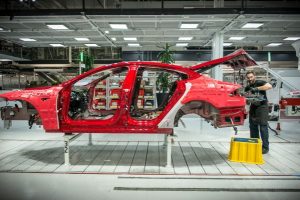Elon Musk on Friday afternoon revealed details of the latest version of Tesla’s Solar Glass Roof, announcing that installations have begun and should ramp up in the coming weeks. This third iteration of the electricity-generating house-topper will be cheaper, easier, and faster to install than its predecessors, Musk said in a public Q&A session. That makes it a viable candidate for the kind of scale the Tesla CEO tends to target, reaching thousands of homes a week in a few months’ time. “It’ll grow like kelp on steroids,” he said. And with enough growth, it could revive Tesla’s stumbling attempt to be not just a carmaker, but an energy company.
Rather than installing solar panels on an existing roof (a service Tesla also offers), this product is the roof. It’s made of glass tiles that can turn photons into electricity. From the ground, the tiles are meant to be indistinguishable from opaque slate, assuaging concerns about a trade-off between helping the environment and hurting one’s eyes. Musk showed off the first version of the product in 2016, and never disclosed the second version until Thursday. The latest version comes with a 25-year warranty and a promise that the glass can withstand 110-mph winds and chunks of hail nearly 2 inches in diameter.
For years, Musk has said that the solar roof and Powerwall (basically a big battery that allows owners to store energy produced by solar power, instead of sending it to the grid) are important to the company’s quest to accelerate the adoption of clean energy. But in the three years since it started taking reservations for the solar roof, Tesla has struggled with the product, delaying its launch and winning relatively few installations. The second version, Musk said Friday, was so expensive to produce and install that Tesla was “basically trying not to lose money.” The edges, especially where the tiles met gutters, were “very artisanal” and often completed at the work site, making for a complicated and time-consuming installation. In the second quarter of this year, Tesla installed just 29 megawatts of solar power—far from its quarterly high of 200.
Version 3.0, he said, uses bigger tiles and different materials (no more detail there), and cuts the number of parts and subassemblies by more than half. Work slowed while Tesla focused its resources on producing its Model 3 sedan, but now that production’s running smoothly—and profitably—it has swung its attention back to the roof.
Musk’s solar ambitions have been troubled by more than delays. The roof started as a partnership with Solar City, which Tesla acquired in 2016 for $2.6 billion. Since then, the business has lost market share, and Tesla shareholders have filed a lawsuit alleging that Tesla overpaid for the company—of which Musk was chairman and the largest stakeholder—given its financial difficulties. It’s also facing a suit from Walmart for breach of contract and gross negligence, after solar panels that Tesla installed on seven Walmart stores allegedly caught fire.
True to form, though, Musk moved on Friday to supersede past and current worries with big promises for the future. He is targeting an eight-hour installation time, about what he said it takes a crew to lay down a simple conventional roof. He promises a price similar to that of a standard roof, too. “We’re coming after you, comp shingle,” he said. Tesla plans to start with in-house crews doing installs, and to start working with other companies once it has nailed down its processes. The tiles will be built at Tesla’s Gigafactory 2 in Buffalo.
Tesla’s home market, at least, may be ready for Version 3.0. As wildfire season ignites, the California utility PG&E has repeatedly turned off electricity to hundreds of thousands of people, in an attempt to stop damaged power lines from starting fires. (That didn’t prevent the Kincade fire, which is now tearing through Sonoma County.) Musk said Tesla has seen a bump in orders in possible response to the power outages, along with more orders for Powerwall units. The idea of a roof that turns sunshine into electricity one can bottle up at home may be strange, “but it’s just a thing that should be,” Musk said. “You can have a live roof instead of a dead one.” And Tesla might have a live energy business, instead of a dead one.
More Great WIRED Stories
- Ripper—the inside story of the egregiously bad videogame
- Planting tiny spy chips in hardware can cost as little as $200
- Netflix, save yourself and give me something random to watch
- The best tech and accessories for your dog
- The former Soviet Union’s surprisingly gorgeous subways
- 👁 Prepare for the deepfake era of video; plus, check out the latest news on AI
- 🎧 Things not sounding right? Check out our favorite wireless headphones, soundbars, and Bluetooth speakers



